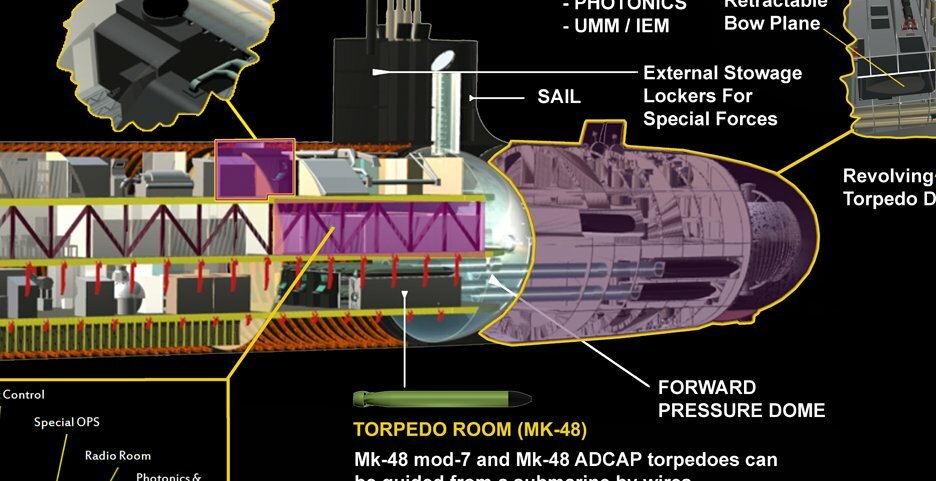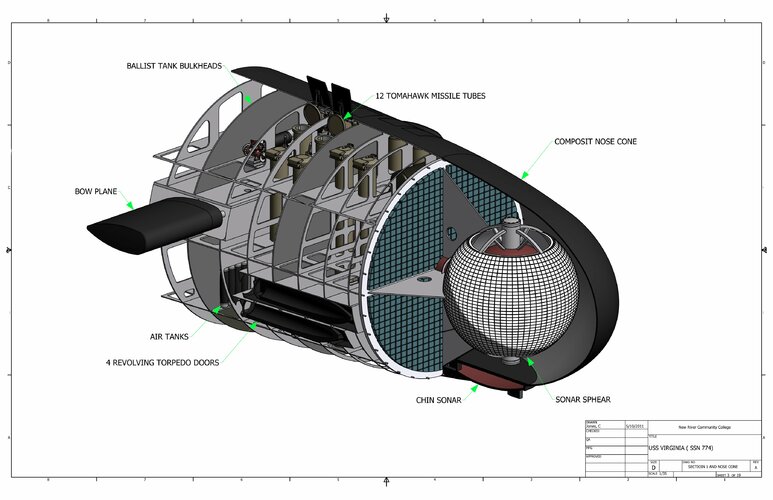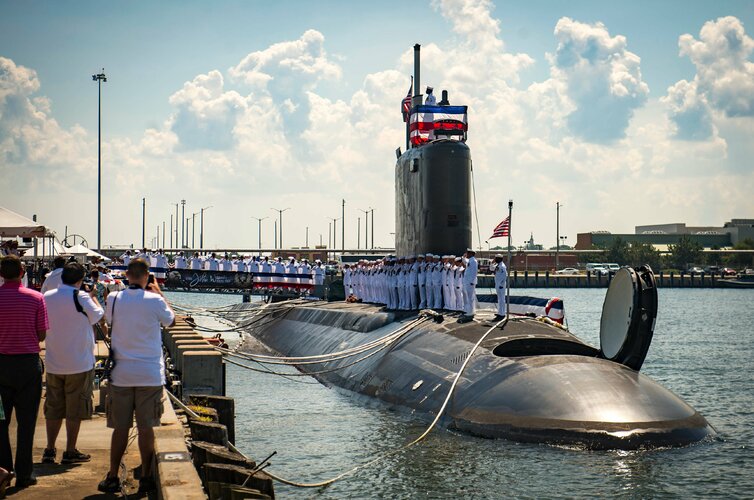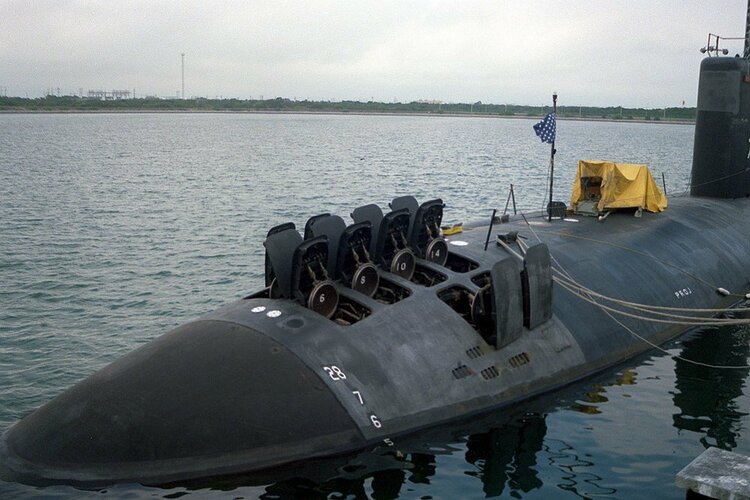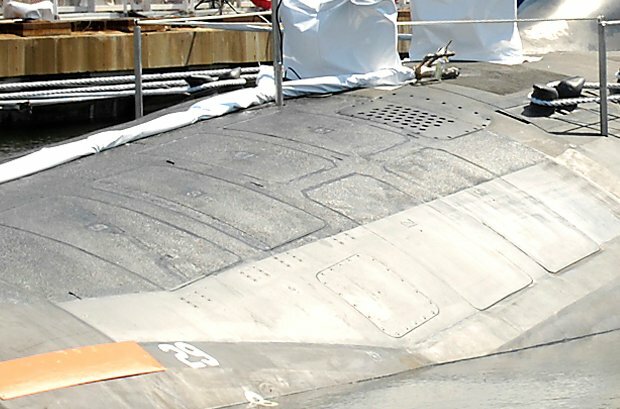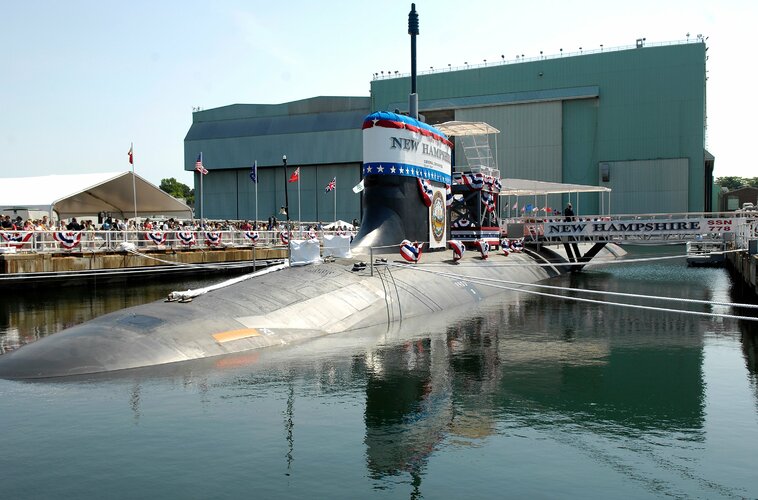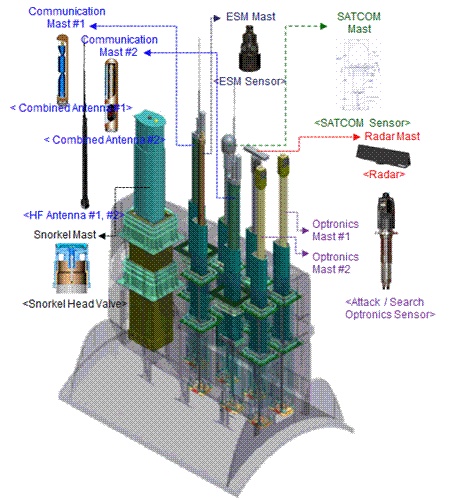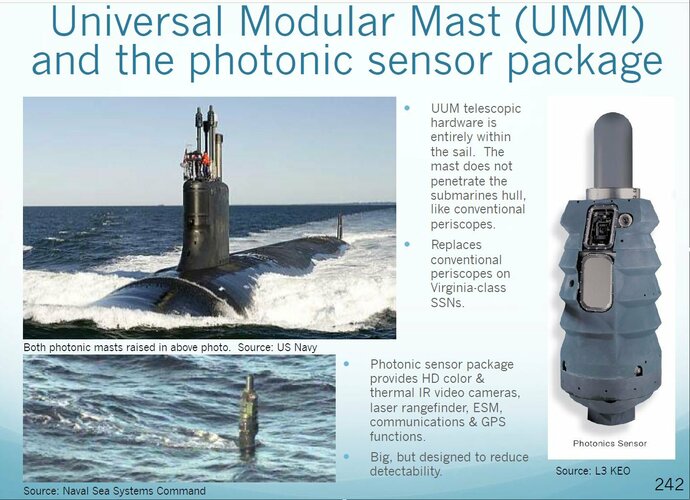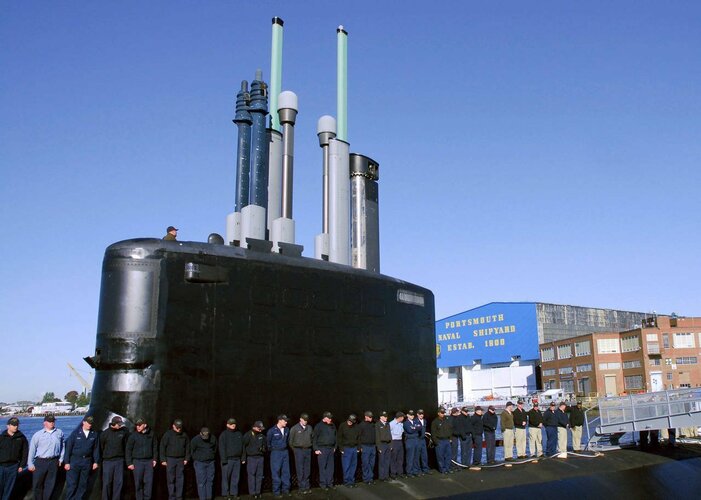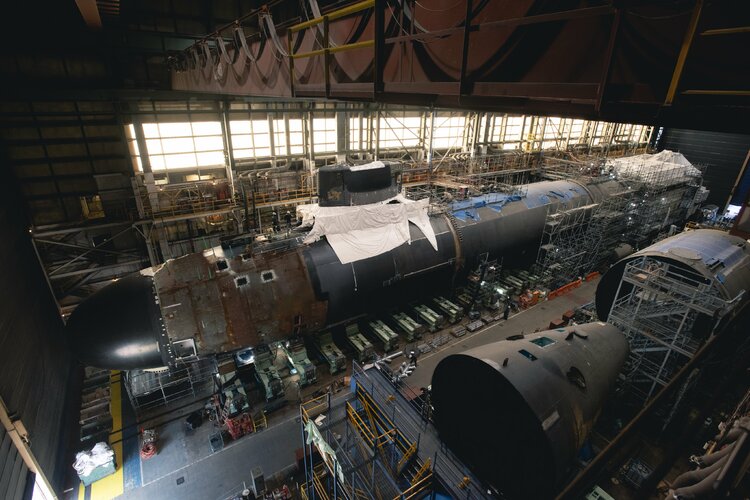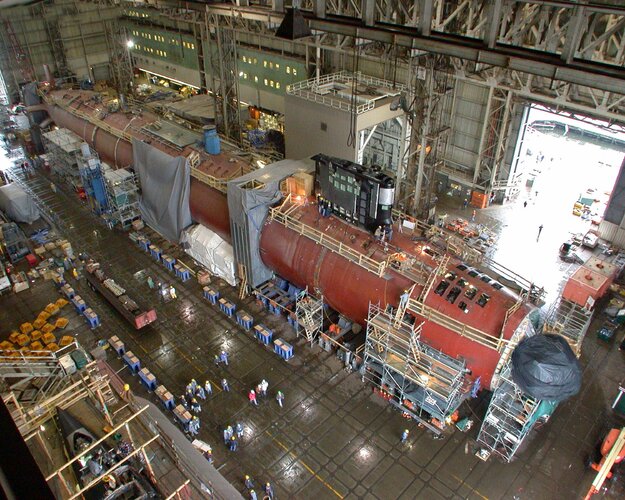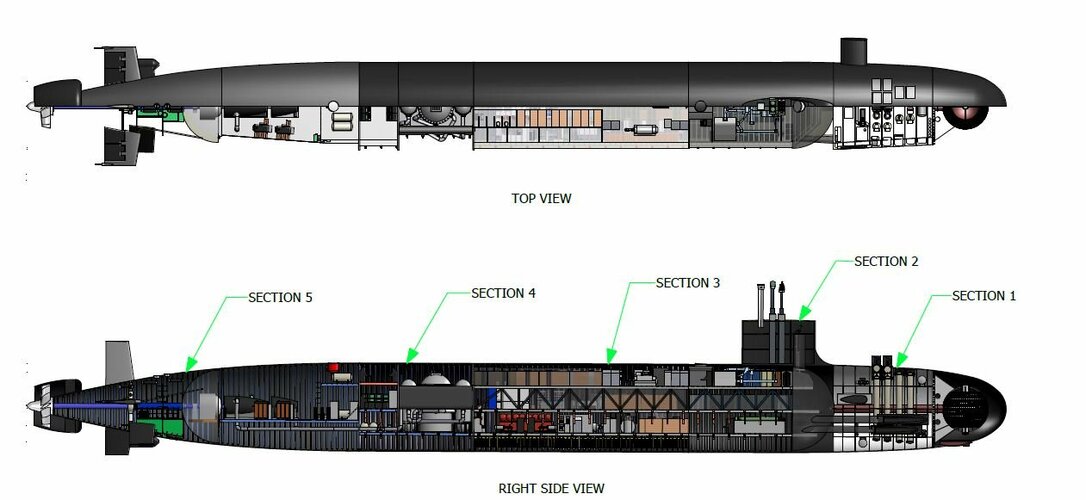You are using an out of date browser. It may not display this or other websites correctly.
You should upgrade or use an alternative browser.
You should upgrade or use an alternative browser.
NSSN Virginia-class - current status and future
- Thread starter Triton
- Start date
Dose anybody know the diameter of the vergina payload module tubes. Thanks.
Thank youDose anybody know the diameter of the vergina payload module tubes. Thanks.
- Joined
- 9 October 2009
- Messages
- 21,928
- Reaction score
- 13,550

Defense firms outsource sub, carrier construction amid labor woes
If the Navy's prime shipbuilders can't bring enough workers to their facilities, they're looking to outsource more work to manufacturers elsewhere.www.defensenews.com
Stupidity galore.
aonestudio
I really should change my personal text
- Joined
- 11 March 2018
- Messages
- 2,961
- Reaction score
- 7,472

Virginia Attack Boat Program Stalled Over Tomahawk, Hypersonic Missile Insurance Rift - USNI News
This post has been updated to reflect the passage of the Fiscal Year 2023 National Defense Authorization Act by the Senate on Tuesday evening. THE PENTAGON — Advanced procurement contracts for two of the Navy’s Block V Virginia-class attack submarines have been stalled for 10 months due to an...
- Joined
- 4 July 2010
- Messages
- 2,510
- Reaction score
- 3,081
HII says their SSN workforce is back to full strength.

 www.defensenews.com
Both yards had prioritized the SSBN program, to the 774s' detriment, but now at least Newport News' lines are at strength.
www.defensenews.com
Both yards had prioritized the SSBN program, to the 774s' detriment, but now at least Newport News' lines are at strength.

Newport News has fully staffed attack sub line, after years of delays
The company has a fully staffed Virginia-class production line, and the company hopes to see improved schedule performance on the remaining Block IV subs.
- Joined
- 21 April 2009
- Messages
- 13,729
- Reaction score
- 7,611

Seabed Espionage Variant Of Virginia Class Submarine In Development
A new variant of the Virginia class nuclear submarine is being developed to execute espionage missions on the seafloor.
- Joined
- 21 April 2009
- Messages
- 13,729
- Reaction score
- 7,611
Virginia Payload Module to Give Subs More Firepower
Virginia Payload Module to Give Subs More Firepower
Forest Green
ACCESS: Above Top Secret
- Joined
- 11 June 2019
- Messages
- 9,412
- Reaction score
- 17,142

U.S. Navy To Get New Unique Submarine: Virginia SSW - Naval News
A new seabed warfare submarine, using a Virginia Class hull, is planned: The Virginia SSW
- Joined
- 21 April 2009
- Messages
- 13,729
- Reaction score
- 7,611

Navy's sub boss Houston tapped to lead naval nuclear power office - Breaking Defense
If confirmed, Houston would take over for Adm. Frank Caldwell, who became naval reactors in 2015.
Scott Kenny
ACCESS: USAP
- Joined
- 15 May 2023
- Messages
- 11,379
- Reaction score
- 13,846
Only problem is launch signature.Might be something like the below, an adaption of ATACMS to submarine cells. Remember this was also when we thought using unarmed Trident II warheads as bunker busters was a good idea.I like the SSTN idea. Probably carry three IRBMs per SLBM tube. Although I prefer a dedicated Columbia conventional strike platform.
If you're going to throw a kinetic bunker buster at someone, it should NOT come from a place that could also carry a nuclear warhead.
- Joined
- 16 April 2008
- Messages
- 9,581
- Reaction score
- 14,398
Only problem is launch signature.
If you're going to throw a kinetic bunker buster at someone, it should NOT come from a place that could also carry a nuclear warhead.
Though we didn't have that concern with SLCM, for some reason.
- Joined
- 21 April 2009
- Messages
- 13,729
- Reaction score
- 7,611
Any ship/sub launched hypersonic missile could have a nuke on it or look initially like a ballistic missile launch. Better scrap all of it.Only problem is launch signature.
If you're going to throw a kinetic bunker buster at someone, it should NOT come from a place that could also carry a nuclear warhead.
Though we didn't have that concern with SLCM, for some reason.
Scott Kenny
ACCESS: USAP
- Joined
- 15 May 2023
- Messages
- 11,379
- Reaction score
- 13,846
Originally, all submarine launched Tomahawks that would be aimed at shore were nuclear warheads. UGM-109A. The -B model was an odd thing, an antiship missile with ludicrous range. Then the -C with a unitary warhead, and -D with the cluster warhead.Only problem is launch signature.
If you're going to throw a kinetic bunker buster at someone, it should NOT come from a place that could also carry a nuclear warhead.
Though we didn't have that concern with SLCM, for some reason.
Once the US formally withdrew all the -As, any SLCM is a lot less threatening. Or at least the US SLCMs are.
There's an immense size and thermal signature difference, not to mention the fact that an SLCM tips over at 200ft and stops climbing.Any ship/sub launched hypersonic missile could have a nuke on it or look initially like a ballistic missile launch. Better scrap all of it.
- Joined
- 21 April 2009
- Messages
- 13,729
- Reaction score
- 7,611
As I said they could all STILL be assumed to have nukes on them. Our adversaries could claim “we assume any ballistic missile is a nuke” to try and control our tech development and deployment options.Originally, all submarine launched Tomahawks that would be aimed at shore were nuclear warheads. UGM-109A. The -B model was an odd thing, an antiship missile with ludicrous range. Then the -C with a unitary warhead, and -D with the cluster warhead.Only problem is launch signature.
If you're going to throw a kinetic bunker buster at someone, it should NOT come from a place that could also carry a nuclear warhead.
Though we didn't have that concern with SLCM, for some reason.
Once the US formally withdrew all the -As, any SLCM is a lot less threatening. Or at least the US SLCMs are.
There's an immense size and thermal signature difference, not to mention the fact that an SLCM tips over at 200ft and stops climbing.Any ship/sub launched hypersonic missile could have a nuke on it or look initially like a ballistic missile launch. Better scrap all of it.
IIRC back a couple decades a couple of oils rig fires initially set off launch detection warnings. Maybe China has much more advance systems that could tell a hypersonic ballistic missile launched from an SSGN to a D5 launched from an Ohio but I doubt it to be honest.
- Joined
- 6 November 2010
- Messages
- 5,245
- Reaction score
- 5,468
'Claim' is not what will get us into trouble when the missiles start flying. What will get us into trouble is the very real suspicion on the adversaries' side that some, or all of the incoming missiles are carrying nukes. A suspicion that can only be disproven after all the warheads have exploded.Our adversaries could claim “we assume any ballistic missile is a nuke”
Would you expect the adversaries to put aside that suspicion when the missiles are flying? Because then I would think you're suffering from terminal optimism.
Last edited:
- Joined
- 21 April 2009
- Messages
- 13,729
- Reaction score
- 7,611
Of course my comment refers to prelaunch even predepoloyment and relates to an adversaries attempt to sway defense policy at home.'Claim' is not what will get us into trouble when the missiles start flying. What will get us into trouble is the very real suspicion on the adversaries' side that some, or all of the incoming missiles are carrying nukes. A suspicion that can only be disproven after all the warheads have exploded.Our adversaries could claim “we assume any ballistic missile is a nuke”
Would you expect the adversaries to put aside that suspicion when the missiles are flying? Because then I would think you're suffering from terminal optimism.
The USSR was highly successful in “stirring up opposition” to any nuclear modernization re: MX, D5, Pershing II, GLCM/ALCM/SLCM, Neutron Bomb, etc. All those weapon systems were going to start WWIII many in the west bought their story.
Scott Kenny
ACCESS: USAP
- Joined
- 15 May 2023
- Messages
- 11,379
- Reaction score
- 13,846
Again.As I said they could all STILL be assumed to have nukes on them. Our adversaries could claim “we assume any ballistic missile is a nuke” to try and control our tech development and deployment options.Originally, all submarine launched Tomahawks that would be aimed at shore were nuclear warheads. UGM-109A. The -B model was an odd thing, an antiship missile with ludicrous range. Then the -C with a unitary warhead, and -D with the cluster warhead.Only problem is launch signature.
If you're going to throw a kinetic bunker buster at someone, it should NOT come from a place that could also carry a nuclear warhead.
Though we didn't have that concern with SLCM, for some reason.
Once the US formally withdrew all the -As, any SLCM is a lot less threatening. Or at least the US SLCMs are.
There's an immense size and thermal signature difference, not to mention the fact that an SLCM tips over at 200ft and stops climbing.Any ship/sub launched hypersonic missile could have a nuke on it or look initially like a ballistic missile launch. Better scrap all of it.
IIRC back a couple decades a couple of oils rig fires initially set off launch detection warnings. Maybe China has much more advance systems that could tell a hypersonic ballistic missile launched from an SSGN to a D5 launched from an Ohio but I doubt it to be honest.
Launch signature.
The rocket motor of a Tomahawk burns for about 5 seconds and only makes about 3500lbs thrust for those 5 seconds, just enough to get the missile out of the water and 200ft up, no significant acceleration.
The first stage of a Trident II burns for about 65 seconds and makes at least 130,000lbs thrust (missile weighs 130klbs), and I believe makes more than 400,000lbs thrust to accelerate at over 3 gees.
Very, very, VERY different amount of thermal bloom involved!!!
If it takes an entire oil rig burning to get enough heat to trip the missile launch warning satellites, that should give you an idea of just how much power it'd take to get there.
Now, I did miss that you were specifying hypersonics. 3M22 Zircon weighs about 7000lbs, which is 1/20 that of a Trident II. Shaurya weighs about the same at 6200kg. Even with a rocket booster running for 65 seconds like a Trident, it's still 1/20 the total energy on a completely different trajectory.
- Joined
- 21 April 2009
- Messages
- 13,729
- Reaction score
- 7,611
Yes obviously, however none of my comments were intended to discuss the different launch signature of any systems per se.Again.As I said they could all STILL be assumed to have nukes on them. Our adversaries could claim “we assume any ballistic missile is a nuke” to try and control our tech development and deployment options.Originally, all submarine launched Tomahawks that would be aimed at shore were nuclear warheads. UGM-109A. The -B model was an odd thing, an antiship missile with ludicrous range. Then the -C with a unitary warhead, and -D with the cluster warhead.Only problem is launch signature.
If you're going to throw a kinetic bunker buster at someone, it should NOT come from a place that could also carry a nuclear warhead.
Though we didn't have that concern with SLCM, for some reason.
Once the US formally withdrew all the -As, any SLCM is a lot less threatening. Or at least the US SLCMs are.
There's an immense size and thermal signature difference, not to mention the fact that an SLCM tips over at 200ft and stops climbing.Any ship/sub launched hypersonic missile could have a nuke on it or look initially like a ballistic missile launch. Better scrap all of it.
IIRC back a couple decades a couple of oils rig fires initially set off launch detection warnings. Maybe China has much more advance systems that could tell a hypersonic ballistic missile launched from an SSGN to a D5 launched from an Ohio but I doubt it to be honest.
Launch signature.
The rocket motor of a Tomahawk burns for about 5 seconds and only makes about 3500lbs thrust for those 5 seconds, just enough to get the missile out of the water and 200ft up, no significant acceleration.
The first stage of a Trident II burns for about 65 seconds and makes at least 130,000lbs thrust (missile weighs 130klbs), and I believe makes more than 400,000lbs thrust to accelerate at over 3 gees.
Very, very, VERY different amount of thermal bloom involved!!!
If it takes an entire oil rig burning to get enough heat to trip the missile launch warning satellites, that should give you an idea of just how much power it'd take to get there.
Now, I did miss that you were specifying hypersonics. 3M22 Zircon weighs about 7000lbs, which is 1/20 that of a Trident II. Shaurya weighs about the same at 6200kg. Even with a rocket booster running for 65 seconds like a Trident, it's still 1/20 the total energy on a completely different trajectory.
They were intended to relate how an adversary will try and make very controversial any new system we are developing for future deployment.
If I did a poor job of that it’s on me I guess.
- Joined
- 3 June 2011
- Messages
- 18,298
- Reaction score
- 12,118
Remember the Europeans screaming about how deploying Pershing IIs and GLCM was going to get them nuked? Did they ever admit they were wrong after the INF Treaty was signed? No? I didn't think so.Of course my comment refers to prelaunch even predepoloyment and relates to an adversaries attempt to sway defense policy at home.'Claim' is not what will get us into trouble when the missiles start flying. What will get us into trouble is the very real suspicion on the adversaries' side that some, or all of the incoming missiles are carrying nukes. A suspicion that can only be disproven after all the warheads have exploded.Our adversaries could claim “we assume any ballistic missile is a nuke”
Would you expect the adversaries to put aside that suspicion when the missiles are flying? Because then I would think you're suffering from terminal optimism.
The USSR was highly successful in “stirring up opposition” to any nuclear modernization re: MX, D5, Pershing II, GLCM/ALCM/SLCM, Neutron Bomb, etc. All those weapon systems were going to start WWIII many in the west bought their story.
- Joined
- 21 April 2009
- Messages
- 13,729
- Reaction score
- 7,611

HII is Awarded Advance Procurement Contract Modification for
HII (NYSE: HII) announced today that its Newport News Shipbuilding division has received a $305.2 million contract modification from General Dynamics Electric B
Scott Kenny
ACCESS: USAP
- Joined
- 15 May 2023
- Messages
- 11,379
- Reaction score
- 13,846
Ah, gotcha!Yes obviously, however none of my comments were intended to discuss the different launch signature of any systems per se.Again.As I said they could all STILL be assumed to have nukes on them. Our adversaries could claim “we assume any ballistic missile is a nuke” to try and control our tech development and deployment options.Originally, all submarine launched Tomahawks that would be aimed at shore were nuclear warheads. UGM-109A. The -B model was an odd thing, an antiship missile with ludicrous range. Then the -C with a unitary warhead, and -D with the cluster warhead.Only problem is launch signature.
If you're going to throw a kinetic bunker buster at someone, it should NOT come from a place that could also carry a nuclear warhead.
Though we didn't have that concern with SLCM, for some reason.
Once the US formally withdrew all the -As, any SLCM is a lot less threatening. Or at least the US SLCMs are.
There's an immense size and thermal signature difference, not to mention the fact that an SLCM tips over at 200ft and stops climbing.Any ship/sub launched hypersonic missile could have a nuke on it or look initially like a ballistic missile launch. Better scrap all of it.
IIRC back a couple decades a couple of oils rig fires initially set off launch detection warnings. Maybe China has much more advance systems that could tell a hypersonic ballistic missile launched from an SSGN to a D5 launched from an Ohio but I doubt it to be honest.
Launch signature.
The rocket motor of a Tomahawk burns for about 5 seconds and only makes about 3500lbs thrust for those 5 seconds, just enough to get the missile out of the water and 200ft up, no significant acceleration.
The first stage of a Trident II burns for about 65 seconds and makes at least 130,000lbs thrust (missile weighs 130klbs), and I believe makes more than 400,000lbs thrust to accelerate at over 3 gees.
Very, very, VERY different amount of thermal bloom involved!!!
If it takes an entire oil rig burning to get enough heat to trip the missile launch warning satellites, that should give you an idea of just how much power it'd take to get there.
Now, I did miss that you were specifying hypersonics. 3M22 Zircon weighs about 7000lbs, which is 1/20 that of a Trident II. Shaurya weighs about the same at 6200kg. Even with a rocket booster running for 65 seconds like a Trident, it's still 1/20 the total energy on a completely different trajectory.
They were intended to relate how an adversary will try and make very controversial any new system we are developing for future deployment.
If I did a poor job of that it’s on me I guess.
Having been an SSBN sailor, I react a bit differently to normal folks.
- Joined
- 21 April 2009
- Messages
- 13,729
- Reaction score
- 7,611

Report on Virginia-class Attack Submarine Program - USNI News
The following is the June 22, 2023, Congressional Research Service report, Navy Virginia (SSN-774) Class Attack Submarine Procurement: Background and Issues for Congress. From the report The Navy has been procuring Virginia (SSN-774) class nuclear-powered attack submarines (SSNs) since FY1998...
- Joined
- 21 April 2009
- Messages
- 13,729
- Reaction score
- 7,611
HII authenticates keel of Virginia-class attack submarine Oklahoma | Shephard
HII's Newport News Shipbuilding division (NNS) has authenticated the keel of the Virginia-class attack submarine Oklahoma (SSN 802), marking an important milestone in the construction process of the first boat built to Block V standard.
www.shephardmedia.com
Scott Kenny
ACCESS: USAP
- Joined
- 15 May 2023
- Messages
- 11,379
- Reaction score
- 13,846
Should still be delivering 2x hulls, the single purchase for FY2025 means one delivery in 2027 or 2028what about the actual production in 2025?
Forest Green
ACCESS: Above Top Secret
- Joined
- 11 June 2019
- Messages
- 9,412
- Reaction score
- 17,142

Navy Wants A Cheap Heavy Torpedo That Can Be Stockpiled Fast
The Navy is eyeing a torpedo that can be procured fast and efficiently to augment the more advanced Mk 48 ADCAP.
Forest Green
ACCESS: Above Top Secret
- Joined
- 11 June 2019
- Messages
- 9,412
- Reaction score
- 17,142

Lawmakers push for two submarines despite US Navy seeking just one
Rep. Joe Courtney led a panel in pushing back against Navy plans to cut a Virginia-class submarine from its fiscal 2025 spending plans.
Scott Kenny
ACCESS: USAP
- Joined
- 15 May 2023
- Messages
- 11,379
- Reaction score
- 13,846
If they're willing to pay for it, we need to do it. US needs probably thirty more SSNs than we physically own. The combat commands are all screaming for SSN support missions, enough to keep some 86 submarines busy.
Lawmakers push for two submarines despite US Navy seeking just one
Rep. Joe Courtney led a panel in pushing back against Navy plans to cut a Virginia-class submarine from its fiscal 2025 spending plans.www.defensenews.com
- Joined
- 21 April 2009
- Messages
- 13,729
- Reaction score
- 7,611
And it’s currently the weapon system where we maintain the largest technological superiority (F-22/F-35/B-2/B-21 a close second) IMHO.If they're willing to pay for it, we need to do it. US needs probably thirty more SSNs than we physically own. The combat commands are all screaming for SSN support missions, enough to keep some 86 submarines busy.
- Joined
- 9 October 2009
- Messages
- 21,928
- Reaction score
- 13,550
I would say cruisers (preferably nuclear powered) are a far more pressing priority. Shoehorning destroyers into cruiser roles was always clearly going to be a losing proposition in the medium to long term, and things have only gotten worse.If they're willing to pay for it, we need to do it. US needs probably thirty more SSNs than we physically own. The combat commands are all screaming for SSN support missions, enough to keep some 86 submarines busy.
BlackBat242
OK, I changed my personal text ;)
- Joined
- 10 April 2013
- Messages
- 1,457
- Reaction score
- 4,183
They can order it all they want, but the current shipyard worker shortage (which includes the ones building SSN parts) means that they won't get built any faster.If they're willing to pay for it, we need to do it. US needs probably thirty more SSNs than we physically own. The combat commands are all screaming for SSN support missions, enough to keep some 86 submarines busy.
- Joined
- 4 July 2010
- Messages
- 2,510
- Reaction score
- 3,081
This is pretty much the argument the Navy leadership is making. Its not that they don't want 30 more boats or aren't trying to grow the fleet's size, it's that they believe the money this year would be better spent on industry investments to reduce the existing backlog.They can order it all they want, but the current shipyard worker shortage (which includes the ones building SSN parts) means that they won't get built any faster.
I think they would agree that the best route would be to increase Industry investments while also buying the 2 boats, but the congressional budget caps are what they are.
Last edited:
Scott Kenny
ACCESS: USAP
- Joined
- 15 May 2023
- Messages
- 11,379
- Reaction score
- 13,846
No, nuclear powered surface ships aren't worth the overhead costs. Yes, it's easier to make a lot of electrical generation for all the crap you need, but the training, building, and especially overhaul costs haven't been worth it for anything smaller than a carrier.I would say cruisers (preferably nuclear powered) are a far more pressing priority. Shoehorning destroyers into cruiser roles was always clearly going to be a losing proposition in the medium to long term, and things have only gotten worse.
Both the Koreans and the Japanese have adapted the Burke superstructure to a different hull shape (wider and shallower) that has added the flag command spaces that Burkes don't have.
Hopefully Congress can pry some extra money loose for the second boat while still increasing industry investment/enlargement.This is pretty much the argument the Navy leadership is making. Its not that they don't want 30 more boats or aren't trying to grow the fleet's size, it's that they believe the money this year would be better spent on industry investments to reduce the existing backlog.
I think they would agree that the best route would be to increase Industry investments while also buying the 2 boats, but the congressional budget caps are what they are.
BlackBat242
OK, I changed my personal text ;)
- Joined
- 10 April 2013
- Messages
- 1,457
- Reaction score
- 4,183
No, nuclear powered surface ships aren't worth the overhead costs. Yes, it's easier to make a lot of electrical generation for all the crap you need, but the training, building, and especially overhaul costs haven't been worth it for anything smaller than a carrier.
The USN has also decided in the early 1990s that CGNs are too vulnerable, as the hull width did not allow for sufficient compartmentalization beside or below the reactors to keep the reactor compartment/vessel intact if hit by a torpedo or mine, and there was also vulnerability to air attack penetrating through the superstructure to the reactor.*
There has been a law on the books in the USN for decades requiring surface combatant ships** to be nuclear-powered where possible... unless the USN certifies that it would be unacceptable to do so!
The USN has so certified all such ships except aircraft carriers since the law was passed.
* This applies to any cruiser type with a beam less than ~80 feet - meaning only ships larger than the Newport News class heavy cruisers (76' beam) (basically the size of the Alaska class "large cruisers" [90'] or larger) are "safe enough" to be nuclear-powered. CGN-9 Long Beach was the largest of the nuclear-powered "escorts" with a beam of 71' 6". The other DLGN/CGNs had beams of 58'-63'.
** LHAs, LHDs, and LPDs are also subject to the law... note that none of those have the "N" ending on their type designations either.
Could Congress / Navy do a split buy for the boat, where half of the cost is on this years budget and half on next year? The half this year helps keep industry going and showing we are serious about making more, but allowing more money to be allocated for industry investments.Hopefully Congress can pry some extra money loose for the second boat while still increasing industry investment/enlargement.
Scott Kenny
ACCESS: USAP
- Joined
- 15 May 2023
- Messages
- 11,379
- Reaction score
- 13,846
IIRC, when the America-class was getting developed, the analysis of alternatives said that oil would have to stay over $140/barrel for the life of the ship (in whatever year the analysis was done dollars) before an LPHN would be less expensive to operate than a dino-burner.The USN has also decided in the early 1990s that CGNs are too vulnerable, as the hull width did not allow for sufficient compartmentalization beside or below the reactors to keep the reactor compartment/vessel intact if hit by a torpedo or mine, and there was also vulnerability to air attack penetrating through the superstructure to the reactor.*
There has been a law on the books in the USN for decades requiring surface combatant ships** to be nuclear-powered where possible... unless the USN certifies that it would be unacceptable to do so!
The USN has so certified all such ships except aircraft carriers since the law was passed.
* This applies to any cruiser type with a beam less than ~80 feet - meaning only ships larger than the Newport News class heavy cruisers (76' beam) (basically the size of the Alaska class "large cruisers" [90'] or larger) are "safe enough" to be nuclear-powered. CGN-9 Long Beach was the largest of the nuclear-powered "escorts" with a beam of 71' 6". The other DLGN/CGNs had beams of 58'-63'.
** LHAs, LHDs, and LPDs are also subject to the law... note that none of those have the "N" ending on their type designations either.
I don't know if they can.Could Congress / Navy do a split buy for the boat, where half of the cost is on this years budget and half on next year? The half this year helps keep industry going and showing we are serious about making more, but allowing more money to be allocated for industry investments.
Firefinder
ACCESS: Top Secret
- Joined
- 5 October 2019
- Messages
- 1,041
- Reaction score
- 1,887
Remember reading that, it was in pre-2008 dollars.$140/barrel for the life of the ship (in whatever year the analysis was done dollars)
So it be over 200 dollars in 2023, From a low end of 198 in 2008 all the way up nearly 300 if you drop all the way back to 1992.
Me I mainly waiting to see if the Helion Fusion reactor works anywhere near as advertised, which for me be making 2.5 times more then you put in. They say it be roughly 500 megawatts, but even if it only outputs like 100 megawatts if be enough for the navy to look at that HARD. Cause the Safety factors for Fusion are Far FAR FAR loser then Fission. IF it eats a missile you will not be able to measure the amount of radiation basically compare to the outside and you cant melt down at all. Break yes, but you can train that unlike fission deals and again at worse is low beta radiation, which standard Damncon gear for DDGs be rated to stop it without it getting activated.
And you can automaticed to the point of Turbines if you wanted, which Helion is doing. Thrown in that the Big 500 megawatt assembly is smaller then a standard LM2500 turbogenset? Be a damn near drop in replacement. Only issue being needing to throw in a set of electric motors to turn the props, which be a bigger design issue for refitting the Burkes imo. The Ships with Intergrited Electric Propulsion like the Type 45 or the Zumwalts be a near plug and play deal.
- Joined
- 9 October 2009
- Messages
- 21,928
- Reaction score
- 13,550
The supposed excessive costliness of nuclear powered cruisers and the like is mostly a myth, dating back primarily to the 1960s and the shenanigans of the McNamara era. For example, back in the 1980s it emerged that the cost of the Virginia-class cruiser (originally nuclear powered frigates prior to the great cruiser panic of the Carter period) was exaggerated by among other things the amortisation of the costs of a shore infrastructure originally planned to support around 40 ships having to be spread among only 4 ships. The original plan for what was then the DLGN program was to have at least 4 frigates for each of the then 8 planned CVN-68 (Nimitz) CVBGs, for a minimum procurement of 32 frigates. However given the hostility of McNamara to the CVN-68 program, the carrier admirals were increasingly forced to resort to drastic tactics to keep the program alive, among which I believe was not only quietly shifting funds and other resources from the DLGN program to the beleaguered CVN-68 program, but also moving R&D and other costs from the balance sheet of the latter program to that of the former. All of which ultimately ended up drastically reducing procurement of the DLGNs while (seemingly) driving their costs sky high, even before one took into account shore infrastructure designed for a much greater number of nuclear powered frigates.No, nuclear powered surface ships aren't worth the overhead costs. Yes, it's easier to make a lot of electrical generation for all the crap you need, but the training, building, and especially overhaul costs haven't been worth it for anything smaller than a carrier.
The USN has also decided in the early 1990s that CGNs are too vulnerable, as the hull width did not allow for sufficient compartmentalization beside or below the reactors to keep the reactor compartment/vessel intact if hit by a torpedo or mine, and there was also vulnerability to air attack penetrating through the superstructure to the reactor.*
There has been a law on the books in the USN for decades requiring surface combatant ships** to be nuclear-powered where possible... unless the USN certifies that it would be unacceptable to do so!
The USN has so certified all such ships except aircraft carriers since the law was passed.
* This applies to any cruiser type with a beam less than ~80 feet - meaning only ships larger than the Newport News class heavy cruisers (76' beam) (basically the size of the Alaska class "large cruisers" [90'] or larger) are "safe enough" to be nuclear-powered. CGN-9 Long Beach was the largest of the nuclear-powered "escorts" with a beam of 71' 6". The other DLGN/CGNs had beams of 58'-63'.
** LHAs, LHDs, and LPDs are also subject to the law... note that none of those have the "N" ending on their type designations either.
Indeed, the so-called Carrier mafia have made a total mockery of that law, along with their entirely fallacious criteria for CGN survivability, all to ensure that any and all resources for nuclear powered surface vessels goes solely into CVNs. However, I rather suspect that the end result of all that is going to bite them in the butt in the near future big time, pardon my French.
Similar threads
-
SSN (X) - Seawolf Redux or something far larger?
- Started by Ironmiked
- Replies: 240
-
CGN-38 Virginia Class Cruisers - Midlife Upgrades
- Started by Ironmiked
- Replies: 48
-
Los Angeles-class Replacement Concepts/Seawolf-class
- Started by Triton
- Replies: 14
-
-

